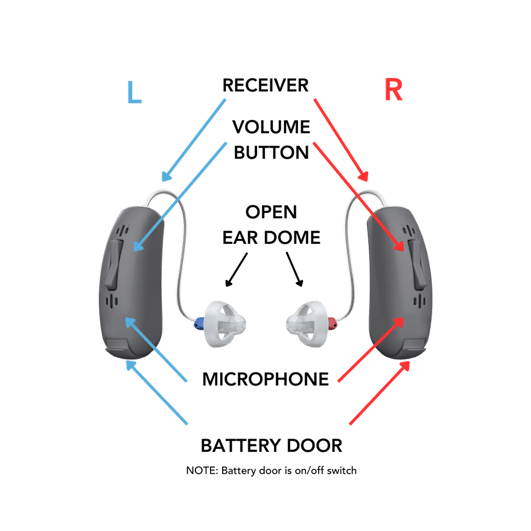Did you know that in the U.S., about 40 million adults experience some degree of hearing loss? If...
What’s the Difference Between Prescription Hearing Aids, OTC, PSAPs, BTEs & More?
Hearing loss is a widespread concern affecting millions globally, and with advancements in technology, numerous options exist to address it. However, understanding the differences among these solutions can be daunting.
In this article, we'll explore various types of hearing aids, including Behind-the-Ear (BTE) devices, Over-the-Counter (OTC) Hearing Aids, Self-Fitting OTC Hearing Aids, OTC Wearables, Personal Sound Amplification Systems (PSAPs), and Prescription Hearing Aids. It's crucial to grasp these options and consider FDA guidelines for both OTC and prescription hearing aids to make informed decisions about hearing health.
Important Hearing Aid Terminology: BTE & RIC
When it comes to understanding the design of hearing aids, there are two types of terms you'll want to grasp:
Behind-the-Ear (BTE) Hearing Aids and Receivers-in-the-Canal (RIC)
BTE Hearing Aids represent state-of-the-art technology for a variety of hearing loss types and severities. These versatile devices are available in both over-the-counter (OTC) and prescription versions to address your specific needs.
BTE devices rest behind the ear and connect to speakers, known as Receivers-in-the-Canal (RIC), which sit inside the ear. Thin, clear wires RICs to BTE devices, offering a nearly invisible solution.
BTE hearing aids have a range of advanced features such as Bluetooth connectivity and directional microphones which contribute to enhanced sound quality.

The FDA Guidelines for OTC Hearing Aids
In October 2022, the FDA, opened the door to a new era of hearing health by permitting the sale of non-prescription air-conduction hearing aids for adults aged 18 and older with perceived mild to moderate hearing loss. These user-controlled devices, often adjustable by tools, tests, or software, can be customized to individual hearing needs. Featuring wireless technology and potential self-assessment tools, OTC hearing aids are available over the counter without the supervision or prescription of a licensed professional.
Self-Fitting OTC Hearing Aids vs Standard OTC Hearing Aids
There are two categories of OTC hearing aids: Self-Fitting OTC Hearing Aids and standard OTC Hearing Aids.
Self-Fitting Over-the-Counter (OTC) Hearing Aids
It's essential to discuss Self-Fitting Over-the-Counter (OTC) Hearing aids and the corresponding FDA requirements.
Self-Fitting OTC hearing aids allow users to program and adjust them independently using technology and software, eliminating the need for professional assistance. These devices offer greater customization through features such as hearing tests and smartphone apps, providing convenience and accessibility for users to fine-tune their hearing experience.
The FDA mandates stringent regulations for this category to ensure safety and efficacy. Manufacturers must provide comprehensive instructions for self-fitting and programming, along with clear guidelines on usage and maintenance. Additionally, these devices must undergo rigorous testing to meet FDA standards for quality and performance. Understanding these requirements is crucial for consumers considering self-fitting OTC hearing aids, as it ensures they can make informed decisions and use the devices effectively to manage their hearing loss.
Over-the-Counter (OTC) Hearing Aids:
Standard OTC Hearing Aids, regulated by the FDA, are less customizable than self-fitting OTC hearing aids and typically do not utilize software or apps for customization. However, they still meet FDA safety and efficacy standards, providing reliability to users.
Alternatives to Hearing Aids: PSAPS & Wearables
Other options that can help with hearing augmentation are PSAPs and over-the-counter wearable devices.
Personal Sound Amplifiers (PSAPs):
PSAPs amplify sounds for recreational activities like hunting or birdwatching and are not recommended for people with hearing impairment. PSAPs are not regulated by the FDA but sometimes are marketed as alternatives to hearing aids. They lack the professional guidance and personalized programming crucial for optimal hearing assistance. These devices are more appropriate for people that have normal hearing, but want to enhance their listening experience in certain circumstances.
Over-the-Counter Wearables:
OTC Wearables encompass a broader category of devices, including those with functionalities beyond basic hearing assistance, such as fitness tracking and augmented reality. Some OTC Wearables may provide ambient sound amplification, aligning with both hearing and other lifestyle needs.
What Are Prescription Hearing Aids?
A prescription hearing aid is any hearing aid that is not an OTC hearing aid. Prescription hearing aids are only available through a licensed hearing health care professional who can program the device to your unique level of hearing loss. These devices may be appropriate for all levels of hearing loss and for all ages based on the indications for use. They undergo comprehensive assessments and personalized programming by audiologists or professionals and can only be sold by a licensed professional. Tailored to individual needs, they offer various styles and advanced features. Adhering to FDA regulations ensures these devices meet stringent safety and efficacy standards, delivering reliable and effective hearing solutions.
When Should You Use Prescription Hearing Aids vs OTC Hearing Aids?
OTC hearing aids are meant to help people with mild to moderate hearing loss. If you suffer from severe hearing loss, then you should get fitted for prescription hearing aids.
Importance of Being Informed About Your Hearing Aid Options
Understanding the differences between these options and FDA guidelines is crucial for informed decision-making. It ensures individuals select devices aligned with their hearing needs, lifestyle preferences, and safety standards. Purchasing hearing aids without proper knowledge may lead to ineffective solutions, impacting daily functioning and overall well-being.
Navigating the diverse landscape of hearing solutions requires understanding the nuances between PSAPs, OTC Hearing Aids, BTE devices, OTC Wearables, and Prescription Hearing Aids. Compliance with FDA guidelines ensures safety and efficacy, providing confidence in selected devices. Being informed empowers individuals to make educated choices, enhancing their hearing health and quality of life. Consulting with professionals ensures personalized guidance, leading to optimal outcomes in addressing hearing difficulties.



